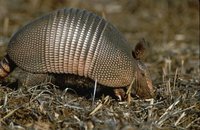Armadillos
|
|
| Armadillo | ||||||||||
|---|---|---|---|---|---|---|---|---|---|---|
 | ||||||||||
| Scientific classification | ||||||||||
| ||||||||||
| Genera | ||||||||||
|
Chlamyphorus |
Armadillos are any of several small mammals of the family Dasypodidae, mostly known for having a bony armor shell. Their average size is about 75 centimeters (30 inches), including tail. All species are native to the American continents, where they inhabit a variety of environments. In the United States, the sole resident armadillo is the 9-banded armadillo, which is most common in the central southern states, particularly Texas.
The armadillo is a placental mammal of the order Xenarthra, related to the anteater. There are several species of armadillo, mainly distinguished by how many bands they have on their armor. It is a prolific digger, and uses its sharp claws to burrow both to feed on grubs and to dig dens in moist soil near the creeks, streams, and arroyos it generally lives and feeds near. Its diet consists mainly of insects, grubs, and other invertebrates.
The main defense of all armadillos is an armor-like outer skin. They are made up of small, overlapping scales called scutes. Nevertheless, the survival tactics of the different subspecies of armadillo vary widely. When threatened by a predator, the South American 3-banded armadillo will roll up into a ball. The North American 9-banded armadillo tends to jump straight in the air when surprised, and consequently often smacks itself into the undercarriage of cars passing over it. This is an example of an animal's reflex made useless, obsolete, and counterproductive by humans.
Armadillos are often used in the study of leprosy, since they are the only known non-human animal species that can contract the disease. They are particularly susceptible due to their unusually low body temperature, which is hospitable to the leprosy bacterium (Mycobacterium leprae).
The 9-banded armadillos also serve science through their unusual reproductive system, in which four identical quadruplets are born in each clutch of armadillos. Because they are always identical, the group of four armadillos provide good subjects for scientific, behavioral, or medical tests that need consistent biological and genetic makeup in the testees. This phenomenon of multiple identical birth, called polyembryony, only manifests in the genus dasypus, not all armadillos as is commonly believed.
The armadillo was, with some resistance, made the state small mammal of Texas[1] (http://www.shgresources.com/tx/symbols/smallmammal/)where it is considered a pest.
Family Dasypodidae
- Subfamily Chlamyphorinae
- Pink Fairy Armadillo, Chlamyphorus truncatus
- Pichiciego, Chlamyphorus retusus
- Subfamily Dasypodinae
- Northern Naked-tailed Armadillo, Cabassous centralis
- Cabassous chacoensis
- Cabassous unicinctus
- Tatouay, Cabassous tatouay
- Little Hairy armadillo or Screaming Hairy armadillo, Chaetophractus vellerosus
- Hairy Armadillo, Chaetophractus villosus
- Chaetophractus nationi
- Nine-banded Armadillo or Long-nosed Armadillo, Dasypus novemcinctus
- Seven-banded Armadillo, Dasypus septemcinctus
- Dasypus hybridus
- Dasypus sabanicola
- Dasypus kappleri
- Hairy Long-nosed Armadillo, Dasypus pilosus
- Six-banded Armadillo or Yellow Armadillo, Euphractus sexcinctus
- Giant armadillo, Priodontes maximus
- Southern Three-banded Armadillo, Tolypeutes matacus
- Three-banded Armadillo, Tolypeutes tricinctus
- Pichi or Dwarf Armadillo, Zaedyus pichiy
One prehistoric ancestor of the armadillo is the glyptodon, which became extinct in the Pleistocene epoch, around 12,000 years ago.
| Contents |
Pictures of Animals
- Classroom Clipart Pictures and Photos of Animals (http://classroomclipart.com/cgi-bin/kids/imageFolio.cgi?direct=Animals)
Animal Clipart
- Animal Clipart (http://classroomclipart.com/cgi-bin/kids/imageFolio.cgi?direct=Clipart/Animals)
Reference
- Texas State Symbols, Emblems, and Mascots (http://www.shgresources.com/tx/symbols/smallmammal/).
External links
- Armadillo Online (http://www.msu.edu/~nixonjos/armadillo/index.html)
- Armadillos.info (http://www.armadillos.info/)
